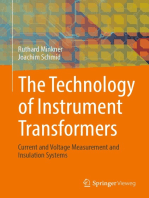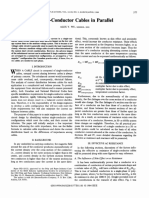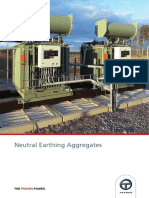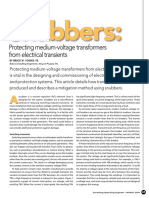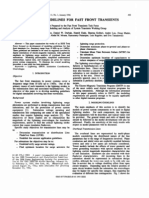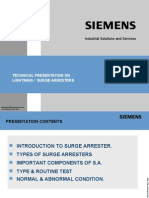Commercial Application of Arc Horns For Arc Current Interruption
Commercial Application of Arc Horns For Arc Current Interruption
Uploaded by
ramsesiCopyright:
Available Formats
Commercial Application of Arc Horns For Arc Current Interruption
Commercial Application of Arc Horns For Arc Current Interruption
Uploaded by
ramsesiOriginal Description:
Original Title
Copyright
Available Formats
Share this document
Did you find this document useful?
Is this content inappropriate?
Copyright:
Available Formats
Commercial Application of Arc Horns For Arc Current Interruption
Commercial Application of Arc Horns For Arc Current Interruption
Uploaded by
ramsesiCopyright:
Available Formats
Arc horn to interrupt single line
grounding current
Commercial application of arc
horns for arc current interruption
------ For low-cost prevention of lightning damage ------
1. Stable power transmission in lightning strikes
2. Arc horn for interruption of single line grounding current
3. Arc horn for interruption of short-circuit current
Brief Note: Takashi CHINO, Senior Research Scientist, Electrical Engineering
Department, Yokosuka Research Laboratory
Stable power transmission in
lightning strikes
Arresters for power transmission have been used on major power transmission lines to prevent lightning
damage, the biggest cause of overhead power transmission line faults in Japan. As this method is expensive,
current efforts are concentrated on developing alternative methods with lower costs. Here at the Institute
we turned our attention to the ability of the arc horn itself to interrupt the discharge (arc discharge)
generated when a lightning bolt strikes the power transmission line and its large current flows to the
ground. Focusing on the fact that high temperature gas is formed by the discharge in the fine tube (arc
interrupting area) of the arc horn, which is made of organic materials, we investigated a technique to
extinguish the arc in this fine tube. As a result, we found it is possible to interrupt the discharge generated
by a lightning strike simply by mounting a fine tube at the tip of the existing arc horn, and successfully
developed this technique for commercial use in a joint study involving power companies and manufacturers.
Lightning strikes on power transmission Protecting overhead power transmission
lines lines from damage by lightning strikes
he electric power generated at a power station is mainly here are three ways to do this. The first is to install
T transmitted through overhead lines. When these overhead T uninsulated cables (overhead grounding cables) at the tops
lines are struck by lightning, an insulation breakdown occurs, of the steel towers used for overhead power transmission lines
forming discharges (arc discharges) at the arc horn, and leading and connect them to the ground. When the overhead grounding
to faults via grounding or short-circuiting. Breakers at line is struck by lightning, the electric current of the lightning
substations are opened and closed, instantaneously preventing flows from the overhead grounding cable to the ground through
ongoing discharge to avoid these faults. the steel towers, and the overhead power transmission line is
Fig. 1 shows the annual number of faults per 100 km of protected from damage by the lightning strike.
power transmission line (termed the fault rate) caused by The second method is installation of arc horns in parallel
lightning strikes, indicating that the rate increases as the to insulators, from which the overhead power transmission
voltage declines. In particular, the fault rate at a voltage of 77 cables are suspended to eliminate damage to insulators caused
kV or less is around 4-5, representing more than half of the by arc discharge resulting from lightning strikes. The third
total. Service would be significantly improved therefore, if method involves an arrester, through which the energy of the
instantaneous blackouts due to the operation of breakers were lightning bolt is released to the ground during a lightning strike
avoided by eliminating arc discharges in lightning strikes. before overhead power transmission cables can be damaged.
In normal operations, the above three methods are applied
6 simultaneously to avoid damage by lightning strike. Since the
1980-1996 5.15
(Number of faults/100km・year)
5
4.45 Winter arrester is the most
Overhead Arrester
effective and the most grounding cable
4
transmission cable
Fault rate
3.18
Overhead power
costly, our efforts have Arc horn
3
Summer been concentrated on the
2
1.30 development of a low-
1
0.56 cost means of protecting
0 against lightning damage
500 275-187 154-110 77-66 Less than 66
Voltage class (KV) (See Fig. 2).
Overhead power transmission line faults caused by
lightning strikes (Fig. 1) Overhead power transmission line setup (Fig. 2)
Arc horn for interruption of
single line grounding current
Development of arc extinguishing unit Features of the arc horn developed by
and arc horn the author
e have developed an arc horn extinguisher capable of he arc interruption unit is made from polyvinyl chloride,
W interrupting the relatively small single line grounding T and is mounted on the end of the arc horn on the
currents* of a few hundred amperes that flow in the arc horn grounding side. The unit allows interruption of a single line
during damage by lightning. This device utilizes the fact that grounding current of 445A up to 10 times. Arc discharges are
the temperature of arcs flowing inside the interrupter may be likely to occur on the outside of the arc interrupter during
up to 5000 or more. Namely, the pressure in the interrupter lightning damage, because the arc horn on the grounding side
is raised as the inside surface is separated and evaporated by and the tip horn inside the interrupter have a complex
the arc, and the arc discharge is interrupted by ejected gas. arrangement of electrodes. A shade was therefore installed on
We developed a low cost arc horn that interrupts single the arc interrupter to ensure that arc discharges are formed on
line grounding current, by mounting the arc interrupter to the the inside of the interrupter. The arc horn is designed to
end of the arc horn, and placing it in the right position relative ensure thermal influence on insulators and other components
to the opposite arc horn, and confirmed that when this arc horn is avoided, even when a short-circuit current around 20 times
for interrupting single line grounding current is mounted on an greater than the single line grounding current flows. features
overhead power transmission line, the arc discharge during are that a technician can watch the section activated from
lightning damage is interrupted by the arc horn itself, and beneath the overhead power transmission line, and accidents
accordingly, breakers at substations are not activated, caused by birds touching the arc horn are avoided.
providing a stable and continuous power supply even when
damage has been caused by lightning.
* Grounding of cable in a power transmission system (comprising three
overhead power transmission cables)
* "Grounding" refers to the phenomenon by which a cable comes into
contact with the ground and electric current flows.
Suspension arrangement
Horn on the grounding side
Insulating cover Horn on line
Tip horn
Shade Arc interrupter
Arc discharge
Hole penetration Insulator
by short-circuit current
Horn on line
Intermediate electrode Electric cable
・
・
・・
・・
・
・・
・・
・
・・
・・
・
・・
・・
・
・・
・・
・
・・
・・
・
・・
・・
・
・・
・・
・
・・
・・
・
・・
・・
・
・・
・・
・
・・
・・ ・
・
・・
・・
・
・・
・・
・
・・
・・
・
・・
・・
・
・・
・・
・
・・
・・
・
・・
・・
・
・・
・・
・
・・
・・
・
・・
・・
・
・・
・・
・
・・
・・
End cap ・
・・・・・
・・・・・
・・・・・
・・・・・
・・・・・
・・・・・ ・
・・・・・
・・・・・
・・・・・
・・・・・
・・・・・
・・・・・
Structure of arc interrupter (Fig. 3) Developed arc horn (Fig. 4)
Arc horn for interruption of
short-circuit current
Improving interrupting performance Verification using real line
he arc horn was installed on a 77kV power transmission
T T
he arc horn for interruption of single line grounding
current was not able to extinguish short-circuit current *. line belonging to one of the power companies involved in
As short-circuit faults often occur among faults by lightning the joint study, and it was confirmed that the arc horn for
damage to power transmission lines, an arc interruption unit short-circuit current interruption operated normally in the
and arc horn were developed for short-circuit current event of lightning strike to the power transmission line in
interruption on 66kV and 77kV power transmission lines. The August, when thunderstorms are most frequent. Power supply
short-circuit current is greater than the single line grounding was found to continue in a stable manner despite lightning
current. Upgrading the materials used in the interrupting damage.
section from polyvinyl chloride to polyamide resin and
mounting the arc interruption unit on both arc horns made it
possible to interrupt a short-circuit current arc of 9000A.
Brief Note
* Short-circuit of two or more cables in a single power transmission
system (comprising three power transmission cables) Takashi CHINO
* "Short-circuit" means that a current flows between two or more Senior Research Scientist
broken cables. Electrical Engineering Department
Yokosuka Research Laboratory
Demand for low-cost measures to
prevent lightning damage and
maintain a stable power supply has intensified in
recent times. The author has developed an arc horn
that meets these requirements through a joint study with
the Kansai Electric Power Co., INC., the Tokyo Electric
Power Company, and NIPPON KATAN Corporation.
The author hopes to contribute to reducing the cost of
power supply by clarifying further the interruption
Installation of arc horn on the short-circuit current mechanism that allows interruption of larger arc
interruption (Fig. 5) currents, and exploring materials for use in interrupting
arcs.
Power transmission line 66kV 77kV
Short-circuit current Short-circuit current 9000A 9000A
interruption performance Degree of multiplicity 5 times 5 times
Grounding current Grounding current 300A 445A
interruption performance Degree of multiplicity 5 times 5 times
Lightning impulse Flashover occurs between both arc horns, passing reliably through the
voltage performance interrupter for lightning pulses of up to about 1300 kV
(Critical conduction performance)
Bird damage The device was confirmed to prevent bird damage, as both arc horns are
prevention function covered with the interruption unit and tubes of polyvinyl chloride.
Activation Operation is detected by the presence/absence of the end cap of the
indication function interruption unit, because it is ejected by activation of interruption unit.
Features of arc horn developed for interruption of 66kV and 77kV short circuit current. (Fig. 6)
november 2002
Central Research Institute of Electric Power Industry
Public Communications Division
Central Research Institute of
Electric Power Industry 1-6-1 Ohtemachi, Chiyoda-ku, Tokyo 100-8126 JAPAN Phone: +81 3 3201 6601 FAX: +81 3 3287 2863
E-mail : www-pc-ml@criepi. denken. or. jp http : //criepi. denken. or. jp
This paper's material is 100% non-wood fiber
You might also like
- IEEE 1119-1988 Guide For Fence Safety Clearence in Electric-Supply StationsDocument14 pagesIEEE 1119-1988 Guide For Fence Safety Clearence in Electric-Supply StationsMIGUEL ANGEL RAIN PENANo ratings yet
- The Technology of Instrument Transformers: Current and Voltage Measurement and Insulation SystemsFrom EverandThe Technology of Instrument Transformers: Current and Voltage Measurement and Insulation SystemsNo ratings yet
- Lightning InjuriesDocument33 pagesLightning InjuriesKrishnaveni Subramani SNo ratings yet
- Antenna Model of Wind Turbine Struck by LightningDocument5 pagesAntenna Model of Wind Turbine Struck by Lightningbal3xNo ratings yet
- RigidBusbarDesign Paper vsIEEEDocument13 pagesRigidBusbarDesign Paper vsIEEEwaqarNo ratings yet
- Assignment 2: Submitted by Name:Zian Tasnim Promy ID:1620521 Course ID:EEE436Document6 pagesAssignment 2: Submitted by Name:Zian Tasnim Promy ID:1620521 Course ID:EEE436Zian TasnimNo ratings yet
- Sheath Voltage CalculationsDocument2 pagesSheath Voltage CalculationssiddharthangandhiNo ratings yet
- Comparison of MCR and SCR Controlled Reactors PDFDocument8 pagesComparison of MCR and SCR Controlled Reactors PDFSaeedAhmedKhanNo ratings yet
- Pirelli PDFDocument24 pagesPirelli PDFFarhan ShahNo ratings yet
- RL - AM-,WWY-: TRV Rating Concepts and Iec Standards TRV EnvelopesDocument17 pagesRL - AM-,WWY-: TRV Rating Concepts and Iec Standards TRV EnvelopesDestinifyd Mydestiny100% (1)
- Surge Arresters: IEC Line Discharge Classes 2, 3, 4 & 5Document5 pagesSurge Arresters: IEC Line Discharge Classes 2, 3, 4 & 5jeffNo ratings yet
- L9-Impulse Voltages and TestingDocument72 pagesL9-Impulse Voltages and TestingDante Filho100% (1)
- One Corner of The Delta TertiryDocument6 pagesOne Corner of The Delta TertiryaocalayNo ratings yet
- 500kV CablesDocument5 pages500kV CablesJaka Sembung GolokNo ratings yet
- Re4H1Le: Type of CableDocument4 pagesRe4H1Le: Type of CableMena KamelNo ratings yet
- In A of Of: Failure Transformer of LevelsDocument9 pagesIn A of Of: Failure Transformer of Levelseeng8124No ratings yet
- Trans Line LADocument8 pagesTrans Line LAsantoshkumarNo ratings yet
- VFT 400 KVDocument9 pagesVFT 400 KVNandkumar ChinaiNo ratings yet
- VFTO Simulation and Testing For 500 KV and 800 KV GIS DisconnectorsDocument10 pagesVFTO Simulation and Testing For 500 KV and 800 KV GIS Disconnectorsjegadeesh kumarNo ratings yet
- Transient Recovery Voltage AnalysisDocument18 pagesTransient Recovery Voltage AnalysisJosNo ratings yet
- Cigré2016 Experiencesandinnovationsinpowertransformershort Circuitcurrentwithstandtesting A2 304Document11 pagesCigré2016 Experiencesandinnovationsinpowertransformershort Circuitcurrentwithstandtesting A2 304cisnatelNo ratings yet
- Improvement of Subsynchronous Torsional Damping Using VSC HVDCDocument6 pagesImprovement of Subsynchronous Torsional Damping Using VSC HVDCRoy Dz HutapeaNo ratings yet
- Impact of Lightning Strikes On Substation Grounding SystemsDocument5 pagesImpact of Lightning Strikes On Substation Grounding Systemsrobert_rjc100% (1)
- CYMGRD Wind Turbine Grounding PDFDocument4 pagesCYMGRD Wind Turbine Grounding PDFjaneth lozanoNo ratings yet
- WTEC 35KV MV Cable LLDPE Rev S 20160226Document5 pagesWTEC 35KV MV Cable LLDPE Rev S 20160226carloNo ratings yet
- Ieee 998 Parte1Document127 pagesIeee 998 Parte1Andres HerreraNo ratings yet
- Code of Practice For Design, Installation and Maintenancefor Overhead Power LinesDocument22 pagesCode of Practice For Design, Installation and Maintenancefor Overhead Power LinesStarla HillNo ratings yet
- AFL Substation Bus DampersDocument12 pagesAFL Substation Bus Dampersabhi120783No ratings yet
- ZIGZAG Transformer and Resistance GroundingDocument2 pagesZIGZAG Transformer and Resistance GroundingMichael Camit EsoNo ratings yet
- Etap ZcociDocument7 pagesEtap ZcociJorgeLabraCanalesNo ratings yet
- Lightning Model For HVDC Transmission Lines: M. You, B. H. Zhang, L. Y. Cheng, Z. Q. Bo, A. KlimekDocument5 pagesLightning Model For HVDC Transmission Lines: M. You, B. H. Zhang, L. Y. Cheng, Z. Q. Bo, A. Klimekqais652002No ratings yet
- Examples Ferroresonance in High Voltage Power System: N. Jacobson, Membec IEEEDocument7 pagesExamples Ferroresonance in High Voltage Power System: N. Jacobson, Membec IEEE_FlyMan_No ratings yet
- Iletken Elektriki Hesaplar 2Document11 pagesIletken Elektriki Hesaplar 2robinknit2009100% (1)
- Difference Between Arcing Horn Gap and Corona RingDocument2 pagesDifference Between Arcing Horn Gap and Corona RingIrfan Ullah67% (3)
- AC Transmission Line LossesDocument8 pagesAC Transmission Line LossesThakur YogendraNo ratings yet
- Single-Conductor Cables in Parallel - Wu, Alex Y.Document19 pagesSingle-Conductor Cables in Parallel - Wu, Alex Y.eero.ylistalo100% (1)
- E680 - Neutral Earthing AggregatesDocument8 pagesE680 - Neutral Earthing AggregatesBadraa BatorgilNo ratings yet
- Insulation Coordination in Power System - Electrical4UDocument13 pagesInsulation Coordination in Power System - Electrical4UR.SivachandranNo ratings yet
- Js 800kv-Hvdc DesignDocument35 pagesJs 800kv-Hvdc DesignbladdeeNo ratings yet
- Snubbers:: Protecting Medium-Voltage Transformers From Electrical TransientsDocument4 pagesSnubbers:: Protecting Medium-Voltage Transformers From Electrical TransientsANTONIO SOLISNo ratings yet
- Approved - 400kV LADocument22 pagesApproved - 400kV LAGuru MishraNo ratings yet
- Modeling Guidelines For Fast Front TransientsDocument14 pagesModeling Guidelines For Fast Front TransientsMagdiel SchmitzNo ratings yet
- Electromagnetic Transient Analysis On 500kV and 230kV Ecuador Transmission ProjectDocument59 pagesElectromagnetic Transient Analysis On 500kV and 230kV Ecuador Transmission ProjectYANDRI PINARGOTE MENENENDEZ100% (2)
- Power Quality AnalysisDocument17 pagesPower Quality Analysis18-208 LingaNo ratings yet
- Pass MoDocument8 pagesPass MoAlexis CastilloNo ratings yet
- 1Neher-McGrath Paper PDFDocument12 pages1Neher-McGrath Paper PDFmordelon468No ratings yet
- Air Core ReactorDocument4 pagesAir Core ReactorBilal AhmadNo ratings yet
- Bus Reactor BHELDocument17 pagesBus Reactor BHELVHMANOHAR100% (2)
- TOR-WG+B1 38+After+laying+tests+on+AC+and+DC+cable+systems+with+new+technologiesDocument2 pagesTOR-WG+B1 38+After+laying+tests+on+AC+and+DC+cable+systems+with+new+technologiesWalter CataldoNo ratings yet
- Raj Emtp ModelDocument123 pagesRaj Emtp Modelmoonsoon_1987100% (1)
- Surge Arrester ModelingDocument3 pagesSurge Arrester ModelingJulián García ZamoraNo ratings yet
- La PresentationDocument15 pagesLa Presentationsandeepg_patil14No ratings yet
- HV DC PrysmianDocument32 pagesHV DC PrysmianFiras AtwanNo ratings yet
- Section Four - Medium Voltage Tr-Xlpe Cables: Explanatory Information 2-13Document56 pagesSection Four - Medium Voltage Tr-Xlpe Cables: Explanatory Information 2-13Terex14253No ratings yet
- IEC 60071 1 PDF Free - CleanedDocument6 pagesIEC 60071 1 PDF Free - Cleanedmichael smairNo ratings yet
- Insulation CoordinationDocument18 pagesInsulation CoordinationIsmael Ochoa JimenezNo ratings yet
- High Voltage Shielded Cable PDFDocument9 pagesHigh Voltage Shielded Cable PDFMohsen_a57No ratings yet
- Design Practice For The Earthing System of The 400 KV Gas InsulaDocument5 pagesDesign Practice For The Earthing System of The 400 KV Gas Insulasorry2qazNo ratings yet
- DRM of OltcDocument4 pagesDRM of OltcBestwick Braveen SylvesterNo ratings yet
- Calculation of Current-Carrying Capacity of Overhead Power Transmission Lines in Different Weather Conditions. 2017Document5 pagesCalculation of Current-Carrying Capacity of Overhead Power Transmission Lines in Different Weather Conditions. 2017GhhNo ratings yet
- Trip of A Zig Zag TransformerDocument22 pagesTrip of A Zig Zag TransformerPranesh PalNo ratings yet
- Session 2004: 21, Rue D'artois, F-75008 Paris © CigréDocument8 pagesSession 2004: 21, Rue D'artois, F-75008 Paris © CigréramsesiNo ratings yet
- Syria LB 24SDocument37 pagesSyria LB 24SramsesiNo ratings yet
- Power Transmission Over Long Distances With CablesDocument8 pagesPower Transmission Over Long Distances With CablesramsesiNo ratings yet
- Trends in Degradation Diagnostic Technique For XLPE Cables in Japan A. Toya, M. Nakade, Y. Okuyama, K. Uchida, H. Tanaka, K. WatanabeDocument7 pagesTrends in Degradation Diagnostic Technique For XLPE Cables in Japan A. Toya, M. Nakade, Y. Okuyama, K. Uchida, H. Tanaka, K. WatanaberamsesiNo ratings yet
- Improved Operation of Cables Connecting Offshore Wind Farms To The Power Grid H. J. Joergensen, J. Hjerrild, C. Jensen and J. Havsager Defu, Eltra and Elkraft System DenmarkDocument8 pagesImproved Operation of Cables Connecting Offshore Wind Farms To The Power Grid H. J. Joergensen, J. Hjerrild, C. Jensen and J. Havsager Defu, Eltra and Elkraft System DenmarkramsesiNo ratings yet
- Practical Experiences From Running A Large: Jan-Olov - Lundberg@svk - SeDocument12 pagesPractical Experiences From Running A Large: Jan-Olov - Lundberg@svk - SeramsesiNo ratings yet
- AORC Panel BI Members. Australia, Malaysia, New Zealand, India, Japan, Singapore, Korea, Hong Kong SAR China, Indonesia and ThailandDocument20 pagesAORC Panel BI Members. Australia, Malaysia, New Zealand, India, Japan, Singapore, Korea, Hong Kong SAR China, Indonesia and ThailandramsesiNo ratings yet
- UATQ1 ResultDocument3 pagesUATQ1 ResultramsesiNo ratings yet
- ADSS Tab 3 - HDWR Assembly InstructionsDocument9 pagesADSS Tab 3 - HDWR Assembly InstructionsramsesiNo ratings yet
- Marine Propulsion: Tailored Solutions ForDocument8 pagesMarine Propulsion: Tailored Solutions ForramsesiNo ratings yet
- Recent Experience Restoring Damaged Transmission Lines by National Power Corporation of The PhilippinesDocument10 pagesRecent Experience Restoring Damaged Transmission Lines by National Power Corporation of The PhilippinesramsesiNo ratings yet
- Appendix H Tables of Conformity (Table A - 1 - OPGW, Duct) : AFL Telecommunications Technical ResponseDocument2 pagesAppendix H Tables of Conformity (Table A - 1 - OPGW, Duct) : AFL Telecommunications Technical ResponseramsesiNo ratings yet
- LindseyDocument14 pagesLindseyramsesiNo ratings yet
- Wikov Gearbox)Document2 pagesWikov Gearbox)ramsesiNo ratings yet
- EzblowDocument22 pagesEzblowramsesiNo ratings yet
- Rodurflex CatalogDocument20 pagesRodurflex CatalogramsesiNo ratings yet
- Lapp Quick-Link Bushings: Instructions For Installation and Removal ofDocument3 pagesLapp Quick-Link Bushings: Instructions For Installation and Removal oframsesiNo ratings yet
- Universal String RollersDocument4 pagesUniversal String RollersramsesiNo ratings yet
- Installation Instructions For Horizontally Mounted Poc Bushings 15 KV Through 72.5 KVDocument2 pagesInstallation Instructions For Horizontally Mounted Poc Bushings 15 KV Through 72.5 KVramsesiNo ratings yet
- Atp U NNMDocument8 pagesAtp U NNMivanramljakNo ratings yet
- Total Lightning Protection For Floating Roof Petroleum Storage Tanks-Feb 2010-Lanzoni PDFDocument12 pagesTotal Lightning Protection For Floating Roof Petroleum Storage Tanks-Feb 2010-Lanzoni PDFmohammed goudaNo ratings yet
- Service Manual: Tigercat H250B HarvesterDocument180 pagesService Manual: Tigercat H250B Harvestertystar_21No ratings yet
- Paulding County Progress June 26, 2013Document14 pagesPaulding County Progress June 26, 2013PauldingProgressNo ratings yet
- Toolbox Talk - Lightning StrikesDocument1 pageToolbox Talk - Lightning Strikessl1828No ratings yet
- User Manual: Geomax Zenith25 Pro SeriesDocument26 pagesUser Manual: Geomax Zenith25 Pro Seriesjuan chilatraNo ratings yet
- Remote Radio Unit (RRU) DC Feed Protection: Document Technical Content Created by M J MaytumDocument26 pagesRemote Radio Unit (RRU) DC Feed Protection: Document Technical Content Created by M J MaytumdiditNo ratings yet
- Revision Mega Goal1 2Document15 pagesRevision Mega Goal1 2tlalhashedm911No ratings yet
- Simulation of Short Circuit and Lightning Transients On 110 KV Overhead and Cable Transmission Lines Using ATP-EMTPDocument14 pagesSimulation of Short Circuit and Lightning Transients On 110 KV Overhead and Cable Transmission Lines Using ATP-EMTPDejanNo ratings yet
- TBT 34 TT-LightningDocument2 pagesTBT 34 TT-LightningfrancisNo ratings yet
- Lightning Current Equipotential Bonding SpdsDocument11 pagesLightning Current Equipotential Bonding SpdsRktBatamNo ratings yet
- EMTP Simulation Lightning MV PDFDocument4 pagesEMTP Simulation Lightning MV PDFCarlos Lino Rojas AgüeroNo ratings yet
- FMDS0511 PDFDocument70 pagesFMDS0511 PDFLiviu PetreusNo ratings yet
- Lightning Protection Risk Management: Date: 4/12/2020 Project No.: 12/008Document15 pagesLightning Protection Risk Management: Date: 4/12/2020 Project No.: 12/008Tan Yu HennNo ratings yet
- GeoMax Zenith15 25 Pro UM v1-1-0 enDocument28 pagesGeoMax Zenith15 25 Pro UM v1-1-0 enJhony Gavidia SNo ratings yet
- Selection of Lighting Prtotection DevicesDocument30 pagesSelection of Lighting Prtotection DevicesnisargoNo ratings yet
- LSC I+II Lightning Strike and Surge CounterDocument2 pagesLSC I+II Lightning Strike and Surge CounterLuis PintoNo ratings yet
- ABB - DPS - 1TXH000416C0201 - OVR Practical Guide QuickSafe - EN PDFDocument146 pagesABB - DPS - 1TXH000416C0201 - OVR Practical Guide QuickSafe - EN PDFDiose MartinsNo ratings yet
- 1TXH000247C0201 OPR Lightning Protection SystemsDocument52 pages1TXH000247C0201 OPR Lightning Protection SystemssrisaecNo ratings yet
- Rolling Sphere LP SF PDFDocument25 pagesRolling Sphere LP SF PDFvsraj1999No ratings yet
- IALA Guideline 2012Document25 pagesIALA Guideline 2012Marcel Streciwilk AntoniolliNo ratings yet
- Class VIIIDocument5 pagesClass VIIIhussainarman4677555555555No ratings yet
- Sports InjuriesDocument128 pagesSports Injuriesagxibaih1100% (5)
- Commercial Application of Arc Horns For Arc Current InterruptionDocument4 pagesCommercial Application of Arc Horns For Arc Current InterruptionramsesiNo ratings yet
- The Infinite Storm The Quasi-Elemental Plane of LightningDocument10 pagesThe Infinite Storm The Quasi-Elemental Plane of LightningjenesuisunsuperherosNo ratings yet
- Lightning Proection System5Document2 pagesLightning Proection System5Pratheep SelvakumaranNo ratings yet
- Abnormal EventDocument2 pagesAbnormal EventMuhammad Haizul RashidNo ratings yet
- 74276-Study On EseDocument109 pages74276-Study On Esestanjack99No ratings yet

